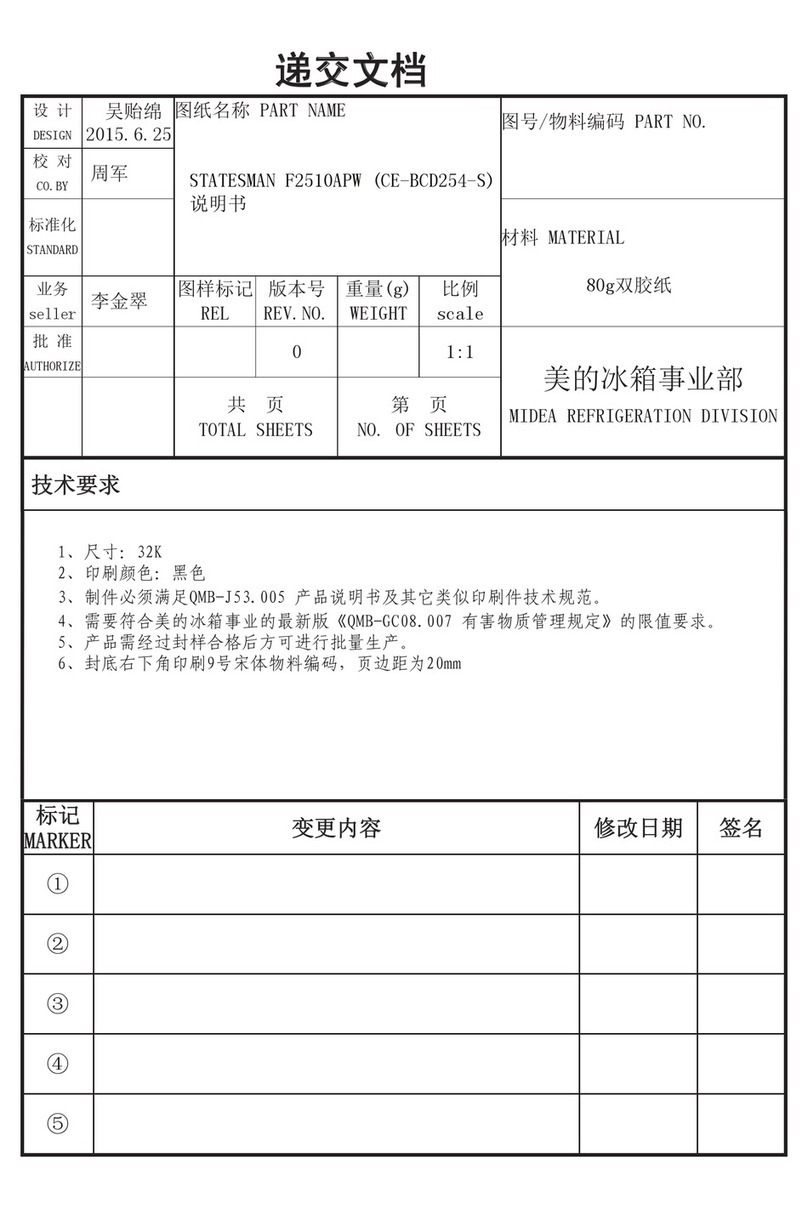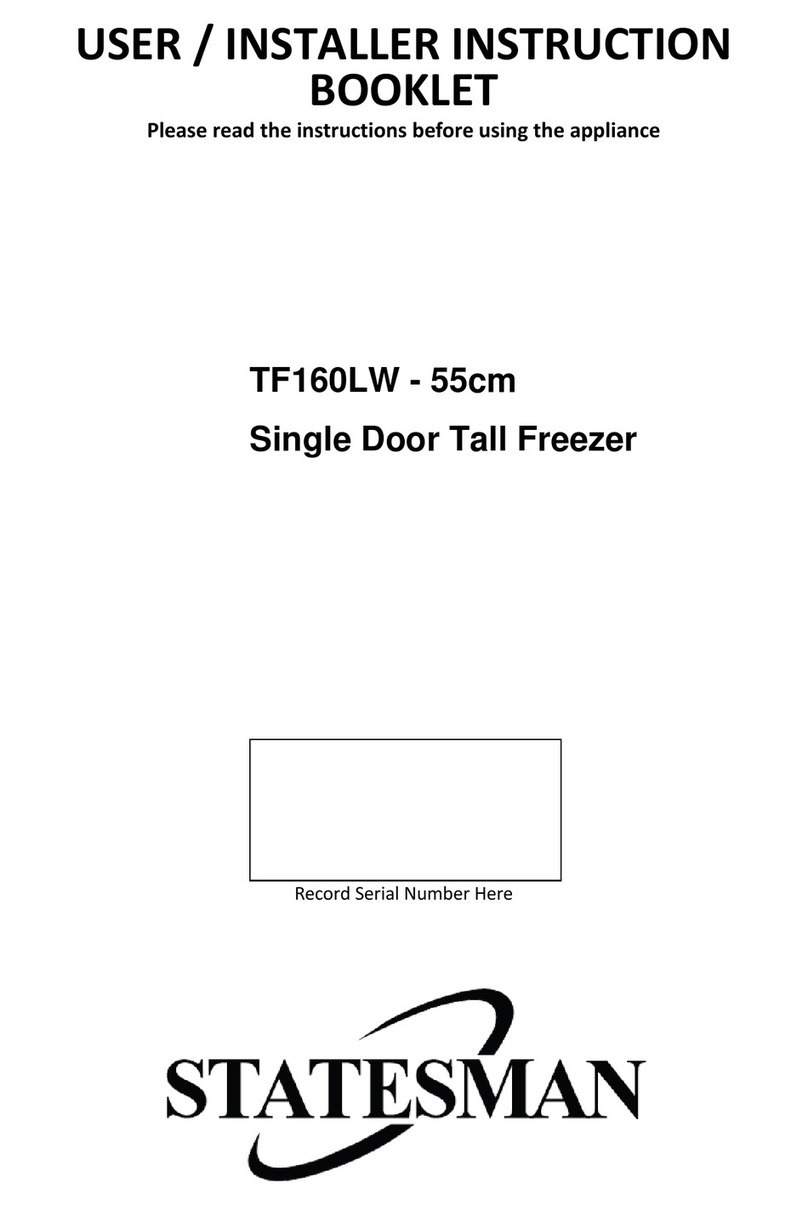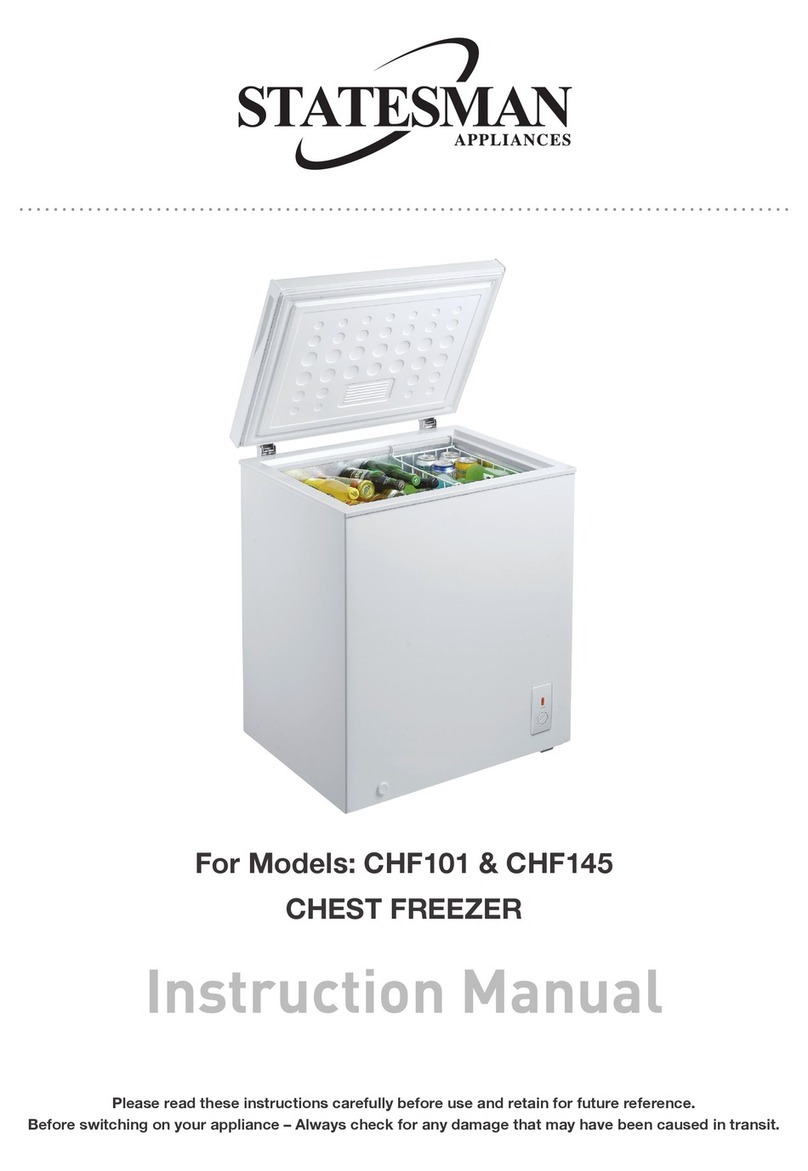STATESMAN TF160LWE User manual

S
(g) scale
1:1
KE
1
TF160LWE
魏赛
汪凯阁
尺寸:16K,16P。
自首单更改技术要求 2020.11.19 汪凯阁
曾磊
(CE-BD160-S)
16131000A40475
2020.10.13
2、
1、
3、
4、

Please read these instructions carefully before use and retain for future reference.
Before switching on your appliance – Always check for any damage that may have been caused in transit.
Instruction Manual
55cm SINGLE DOOR TALL FREEZER
TF160LWE

2
CONTENTS
Safety Instructions..................................................... 3-4
Appliance Overview.......................................................5
Specication..................................................................6
Installation ................................................................. 6-9
Operating Instructions.................................................10
Cleaning & Maintenance .............................................11
Troubleshooting...........................................................12
Fuse Replacement ......................................................13
Disposal Information ...................................................13

3
IMPORTANT SAFETY INSTRUCTIONS
Read and follow all of the instructions even if you feel you are familiar with the
product, and nd a place to keep this manual handy for future reference.
Important: This product is intended for domestic use only; to store and freeze food
products only. When using electrical appliances, basic safety precautions should
always be followed:
• Do not operate the appliance with a damaged cord or plug, after it malfunctions
or has been dropped or damaged in any way. All electrical repairs must be carried
outbyaqualiedelectrician.Inadequaterepairsmayresultinamajorsourceof
danger for the user and invalidate the warranty.
• Check the voltage of the appliance matches the household voltage, which is
located on the rating label.
• Use of an extension cord is not recommended with this product.
• This appliance is not intended for use by persons (including children) with reduced
physical,sensory or mental capabilities, or lack of experience and knowledge,
unless they have beengiven supervision or instruction concerning use of the
appliance by a person responsible for theirsafety. Children should be supervised to
ensure that they don’t play with the appliance.
• Cleaning and user maintenance shall not be made by children
• Keep the appliance and its cord out of reach of children.
• Keepallpackagingwellawayfromchildren.Thereisariskofsuocation
• Appliances can be used by persons with reduced physical, sensory or mental
capabilities or lack of experience and knowledge if they have been given
supervision or instruction concerning use of the appliance in a safe way and
understand the hazards involved.
• Always unplug the appliance before attempting to move. When disconnecting from
the electricity supply, pull the plug and not the cord.
• This product is for indoor use only.
• Donotstoreexplosivesubstancessuchasaerosolcanswithaammable
propellant in this appliance.
• Always keep the ventilation openings clear of obstruction. Should they become
blocked, clear them straight away.
• TherefrigerantofthisproductisR600awhichisammable.Ensurewhenmoving
the appliance or during installation that the cooling system does not get damaged.
• Do not use mechanical devices or other means to accelerate the defrosting
process.
• Do not touch the light bulb if it has been on for a long period of time because it
could be very hot.
• During transportation and installation of the appliance, be certain that none of the
components of the refrigerant circuit become damaged.
• Make sure that the power plug is not squashed or damaged by the back of the
appliance.Asquashedordamagedpowerplugmayoverheatandcauseare.
• Do not remove or touch items from the freezer compartment if your hands are
damp/wet, as this could cause skin abrasions or frost/freezer burns.
• Before disposal of the old appliance, make sure that any locking mechanisms
havebeenbrokeno,doorshavebeenremovedbutshelveshavebeenleftinso
that children cannot easily climb inside. Also remove the plug so the appliance is
unusable.

4
WARNING: The appliance is heavy and care is needed when unpacking and
moving it. Get extra help and only hold the appliance by the casing – never hold
by the door or the trim.
WARNING: Risk of child entrapment.
WARNING:Riskofre/ammablematerials.
• When positioning the appliance, ensure the supply cord is not trapped or
damaged.
• Do not locate multiple portable socket-outlets or portable power supplies at the
rear of the appliance.
• Children aged from 3 to 8 years are allowed to load and unload refrigerating
appliances.
• To avoid contamination of food, pay attention to the following:
• openingthedoorforlongperiodscancauseasignicantincreaseofthe
temperature in the compartments of the appliance;
• clean regularly surfaces that can come in contact with food and accessible
drainage systems;
• cleanwatertanksiftheyhavenotbeenusedfor48hours;ushthewater
system connected to a water supply if water has not been drawn for 5 days;
• storerawmeatandshinsuitablecontainersintherefrigeratorsothatitisnot
in contact with or drip onto other food;
• two-star frozen-food compartments are suitable for storing pre-frozen food,
storing or making ice-cream and making ice cubes;
• one-, two- and three-star compartments are not suitable for the freezing of fresh
food;
• iftherefrigeratingapplianceisleftemptyforlongperiods,switcho,defrost,
clean, dry and leave the door open to prevent mould developing within the
appliance.
The table below contains general guidelines on the storage of food in the refrigerator.
Refrigerator location Type of food
Fridge door • Foodswithnaturalpreservatives,suchasjams,juices,drinks,
condiments.
• Do not store perishable foods.
Crisper bin (salad bin) • Fruits, herbs and vegetables should be placed separately in the
crisper bin.
• Do not store bananas, onions, potatoes, garlic in the refrigerator.
Fridge shelf – bottom
Chiller bin
• Rawmeat,poultry,sh(forshort-termstorage)
Fridge shelf – middle • Dairy products, eggs
Fridge shelf – top • Foods that do not need cooking, such as ready-to-eat foods, deli
meats, leftovers.
Freezer drawer/shelf • Foods for long-term storage.
• Bottomdrawer/shelfforrawmeat,poultry,sh.
• Middle drawer/shelf for frozen vegetables, chips.
• Top drawer/shelf for ice cream, frozen fruit, frozen baked goods.

5
APPLIANCE OVERVIEW

SPECIFICATIONS
Model TF160LWE
Product Dimensions (mm) H 1420 x W 550 x D 550
Frozen Food Storage Volume 160L
Climate Class ST/N
Energy Consumption 235 (kWh/24h)
Airbourne Acoustical Noise 42dB
Energy Rating F
Freezing Capacity 7.2kg/24h
Rated Voltage 220-240V~

7
• Cookedmeat/shshouldalwaysbestoredonashelfaboverawmeat/shtoavoidbacterial
tran
3. Replace the top-hinge and the top-door limit block and the door bearing bush to the other side.
A. Removethenutwithsleeve.Takeothewasherthenremovetheaxestothe
othersideandxed.
B. Remove the door limit block
C. Please taking out another door limit block, with screw mounting to the door
2.Removethescrewsfromthexedtop-hingewithcross-slotscrewdriver.
Screws
4.Disassemblethescrewsxedtothebottom-hingewithcross-slotscrewdriver.

8
Note: The freezer incline angle less 45°.
5.Replacethebottomhingetotheothersidethenxitwithscrews.
6. Set the door to the
rightposition,xthe
mid-hinge.
7. Replace the top-hinge.
Screwsxedto
bottom hinge
8. Set the top door to the right
position,xthetop-hingeand
the cover.

9
9.Replacethelevelertotheothersideandadjustittomakesurethecabinetislevel.
Door Space Requirements
The unit’s door must be able to open fully as shown.
W×D≥902×1052mm
Levelling the Unit
Todothisadjustthetwolevellingfeetatthefrontoftheunit.
If the unit is not level, the door and magnetic seal alignments will not be
covered properly.
Make sure that the foot touches the ground before use.
Look down from the top, turn clockwise to loosen, anti-clockwise to tighten.

10
• Alwaysletpre-cookedfoodcooldownbeforeyouputintheunit.Thiswillhelptomaintainthe
internal temperature of the unit.
• Topreventcoldairescapingfromtheunit,trytolimitthenumberoftimesyouopenthedoor.
We recommend that you only open the door when you need to put food in or take food out.
Tips for Keeping Food in the Unit
• Cookedmeats/shesshouldalwaysbestoredonashelfaboverawmeats/shestoavoid
bacterialtransfer.Keeprawmeats/shesinacontainerwhichislargeenoughtocollectjuicesand
cover it properly. Place the container on the lowest shelf.
• Leavespacearoundyourfood,toallowairtocirculateinsidetheunit.Ensureallpartsoftheunit
are kept cool.
• Topreventtransferofavoursanddryingout,packorcoverthefoodseparately.
Noise inside the Unit!
You may notice that your unit makes some unusual noises. Most of these are perfectly normal, but
you should be aware of them!
These noises are caused by the circulation of the refrigerant liquid in the cooling system. It has
become more pronounced since the introduction of CFC free gases. This is not a fault and will
notaecttheperformanceofyourunit.Thisisthecompressormotorworking,asitpumpsthe
refrigerant around the system.
OPERATING INSTRUCTIONS
Switching On Your Unit
• Thetemperatureselectorknobislocatedonthetopmiddleofthefreezerinterior.
Setting “Min”: Less Cool Temperature
Setting “Med”: Normal Operation (adequate for most situations)
Setting “Max”: Coolest Temperature
• Duringhighambienttemperaturese.g.Onhotsummerdays.Itmaybenecessarytosetthe
Thermostat to the Coolest setting (position“Max”).This may cause the compressor running
continuously in order to maintain a low temperature in the cabinet.
• Forthersttimeyouinstallyourfreezer,setthethermostatknobat“Med”.
Give your freezer time to cool down completely before adding food. It is the best to wait
24 hours before adding food. The thermostat knob controls the temperature.

11
Switching Of for Long Periods of Time
When the unit is not in use for a long period of time, disconnect it from the mains supply, empty all
foodandcleantheappliance,leavingthedoorajartopreventunpleasantsmells.
Care When Handling / Moving Your Unit
Hold the unit around its sides or base when moving it. Under no circumstances should
it be lifted by holding the edges of the top surface.
Servicing
The unit should be serviced by an authorized engineer and only genuine spare parts should be
used. Under no circumstances should you attempt to repair the unit yourself. Repairs carried out by
inexperiencedpersonsmaycauseinjuryorseriousmalfunction.Contactaservicetechnician.
CLEANING & MAINTENANCE
Cleaning the Interior and the Exterior of the Unit
• Dusts behind the refrigerator and on the ground shall be timely cleaned to improve the cooling
eectandenergysaving.
• The interior of the refrigerator should be cleaned regularly to avoid odor.
• Check the door gasket regularly to make sure there are no debris.
• Pleaseturnothepowerbeforecleaning,removeallfood,shelves,drawers,etc.
• Clean the door gasket with mild soap and water.
• Use a soft cloth or sponge to clean the inside of the refrigerator, with two tablespoons of baking
soda and a quart of warm water. Then rinse with water and wipe clean, and open the door and
dry it naturally before the power is turned on.
• Forareasthatarediculttocleanintherefrigerator(suchasnarrowsandwiches,gapsor
corners), it is recommended to wipe them regularly with a soft rag, soft brush, etc. and when
necessary, combined with some auxiliary tools (such as thin sticks) to ensure no contaminant
accumulation in these areas.
• Do not use soap, detergent, scrub powder, spray cleaner, etc., as these may cause odors in the
interior of the refrigerator.
• Clean the bottle frame, shelves and drawers with a mild detergent and dry with a soft cloth.
• Wipe the outer surface of the refrigerator with a soft cloth dampened with soapy water,
detergent, etc., and then wipe dry.
• Do not use hard brushes, clean steel balls, wire brushes, abrasives, such as toothpastes, organic
solvents (such as alcohol, acetone, banana oil, etc.), boiling water, acid or alkaline items clean
refrigerator considering that this may damage the fridge surface and interior. Boiling water and
benzene may deform or damage plastic parts.
• Donotrinsewithwatersoasnottoaecttheelectricalinsulationproperties.
Cleaning Tips
Condensation may appear on the outside of the unit. This may be due to a change in room
temperature.Wipeofanymoistureresidue.Iftheproblemcontinues,pleasecontactaqualied
technician for assistance.

12
TROUBLESHOOTING
If your refrigerator is not working properly, it may be a minor problem,
therefore check the following.
The appliance does not operate, Check if;
• Thereisapowerfailure,
• Themainsplugisnotproperlypluggedin,orisloose
• Thethermostatsettingisonposition“0”,
• Thesocketisdefective.Tocheckthis,pluginanotherappliancethatyouknowwhichisworking
into the same socket.
The appliance performs poorly; Check if;
• Youhaveoverloadedtheappliance,
• Thedoorsarenotclosedperfectly,
• Therearenotenoughventilationductsonthekitchenunitasmentionedinthe
Instal-lation Manual.
If there is noise;
The cooling gas which circulates in the refrigerator circuit may make a slight noise
(bubbling sound) even when the compressor is not running. Do not worry, this is quite
normal.Ifthesesoundsaredierentcheckif;
• TheapplianceisinstalledrmlyasdescribedintheInstallationManual.
• Theobjectsontheappliancearevibrating.
If there is water in the lower part of the refrigerator;
Check if;
The drain hole for defrost water is not clogged (use defrost drain plug to clean the drain hole).
If you are having problems with your appliance, please use our troubleshooting guide below. If you
are unable to resolve the issue using this guide please ring our Customer Service Department on
0844 848 5861. Please have the model code and purchase information available.
Appliance does
not work
Mains plug is not plugged in
or is loose
Insert mains plug.
Fuse has blown or is defective Check fuse, replace if necessary.
Socket is defective Mains malfunctions are to be
corrected by an electrician.
Temperature is set too cold or the
appliance runs at Super modes
Turn the temperature regulation knob
to a warmer setting temporarily.
Appliance is not level. Re-adjustthefeet.
The appliance is touching the
wallorotherobjects.
Move the appliance slightly.
Fault Possible cause Solution
Appliance freezes
or cools too much
Unusual noises

13
Fuse Replacement (Class I)
This appliance must be eathed. Remove the fuse cover with a small
atheadscrewdriver.Takeoutthefuseandreplacewithanewfuse
of the same Amp. Replace the fuse cover and push back into place.
DISPOSAL
TheEuropeanDirective2012/19/EUonWasteElectricalandElectronicEquipment
(WEEE),requiresthatoldhouseholdelectricalappliancesmustnotbedisposedofin
normal unsorted municipal waste.
Old appliances must be collected separately in order to optimise the recovery and
recycling of the materials they contain and reduce the impact on human health and the
environment.
The crossed out “wheeled bin” symbol on the product reminds you of your obligation,
that when you dispose of the appliance it must be separately collected. Consumers
should contact their local authority or retailer for information concerning the correct
disposal of their old appliance.
Fuse Cover
FUSE REPLACEMENT

14

15

0844 848 5861
38 Bluestem Road,
Ransomes Europark
Ipswich, IP3 9RR
Table of contents
Other STATESMAN Freezer manuals

STATESMAN
STATESMAN F2510APW User manual

STATESMAN
STATESMAN BU60FZ4 User manual

STATESMAN
STATESMAN TF160LW User manual

STATESMAN
STATESMAN SBS177X User manual

STATESMAN
STATESMAN CHF102 User manual

STATESMAN
STATESMAN TF170LWE User manual

STATESMAN
STATESMAN LF1355W User manual

STATESMAN
STATESMAN BIC5050S User manual

STATESMAN
STATESMAN F1654APWE User manual

STATESMAN
STATESMAN CHF101 User manual


















